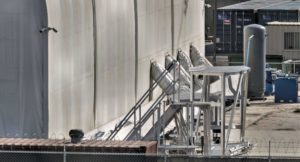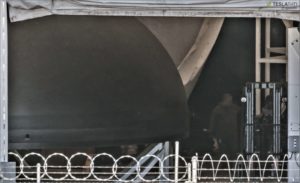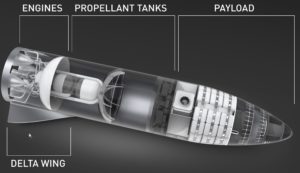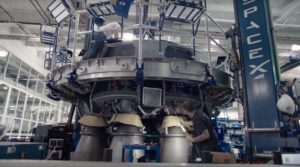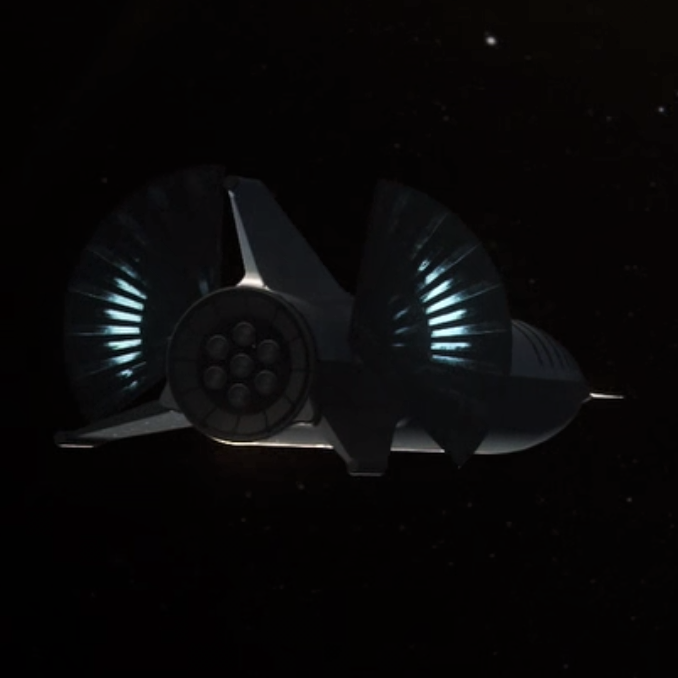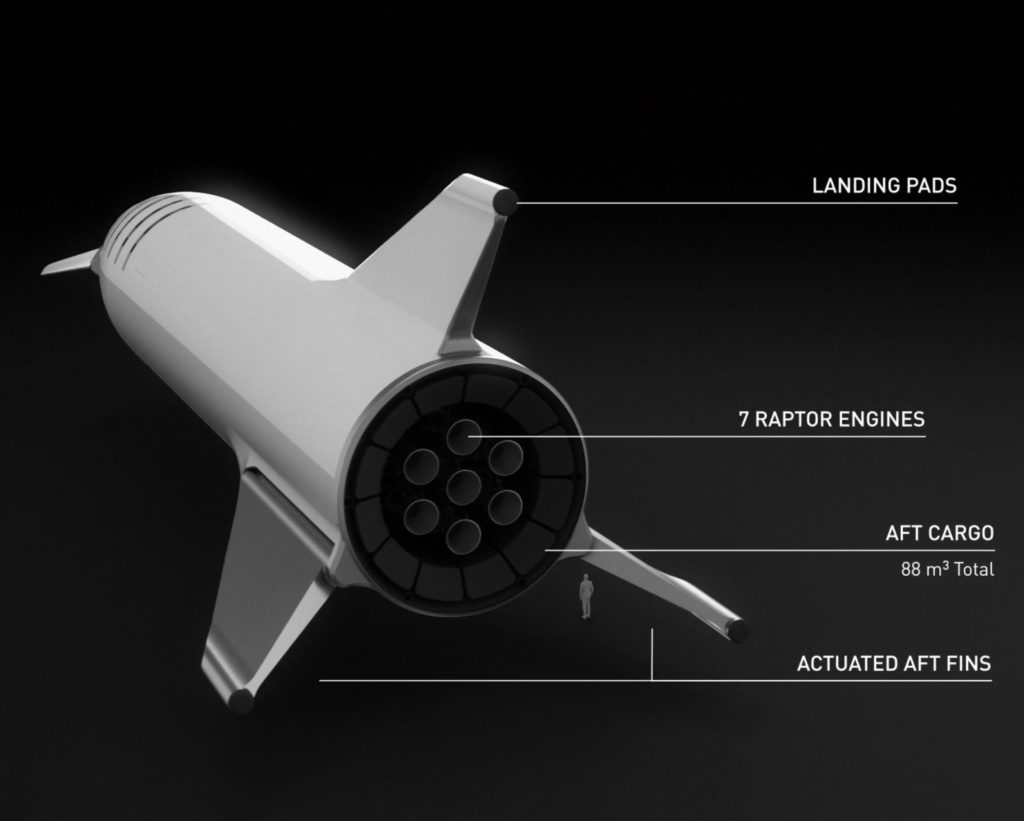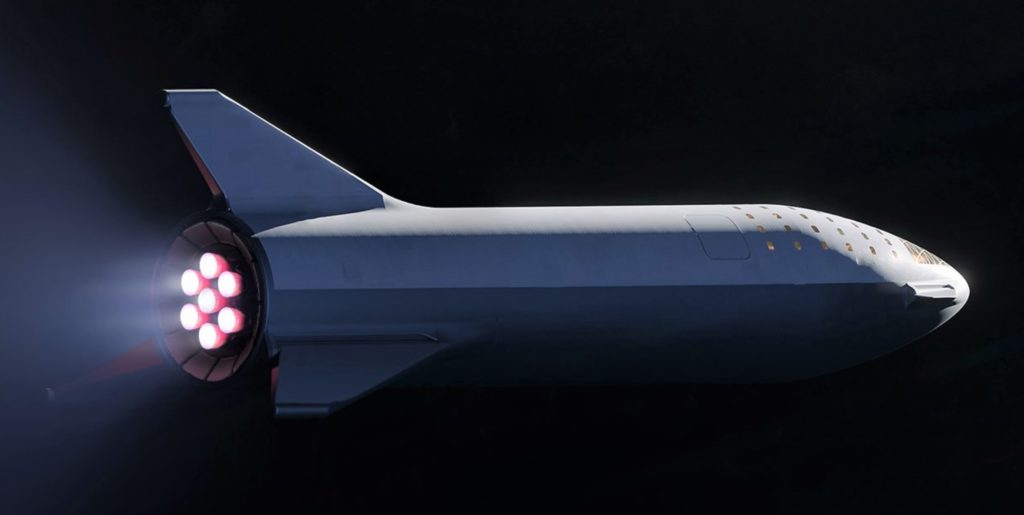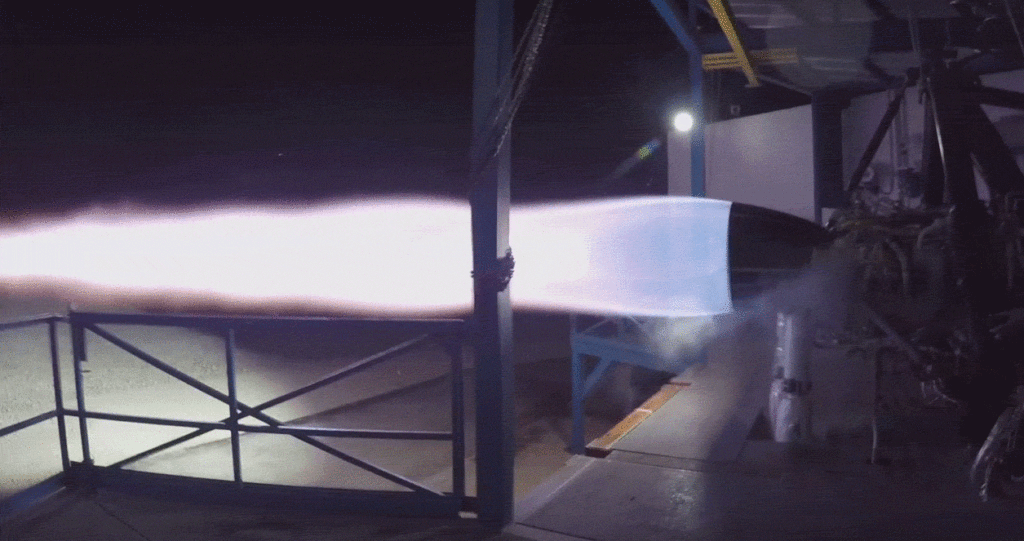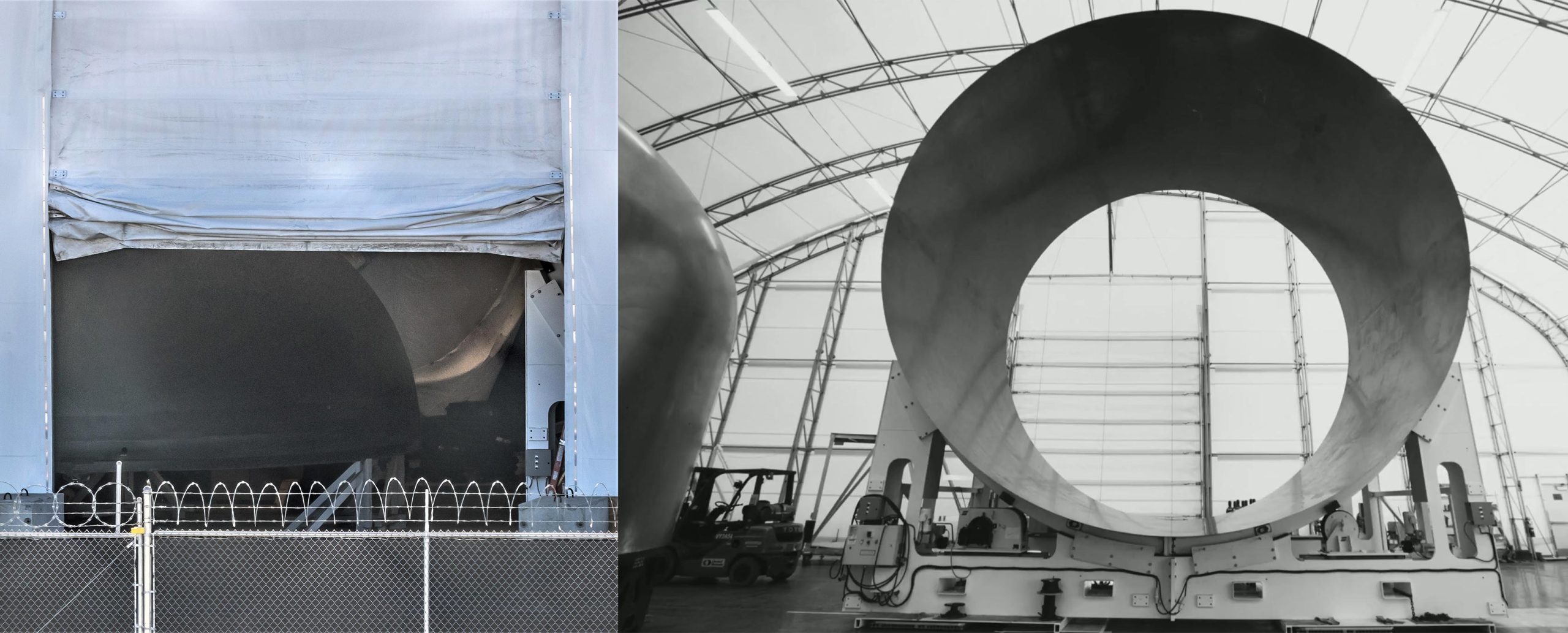
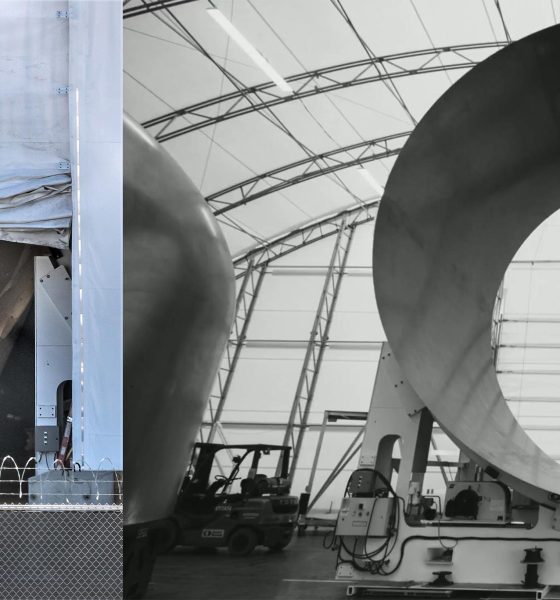
News
SpaceX’s next big BFR spaceship part finished in Port of LA tent facility
The first 9-meter (29.5-foot) diameter composite propellant tank dome for SpaceX’s full-scale BFR spaceship prototype has been spotted more or less complete at the company’s temporary Port of Los Angeles facility, unambiguous evidence that SpaceX is continuing to rapidly fabricate major components of its next-generation rocket.
Speaking at a dedicated BFR update event in mid-September, CEO Elon Musk foreshadowed as much, and recent updates have reiterated just how committed SpaceX is to BFR and just how keen the company is to waste no time at all.
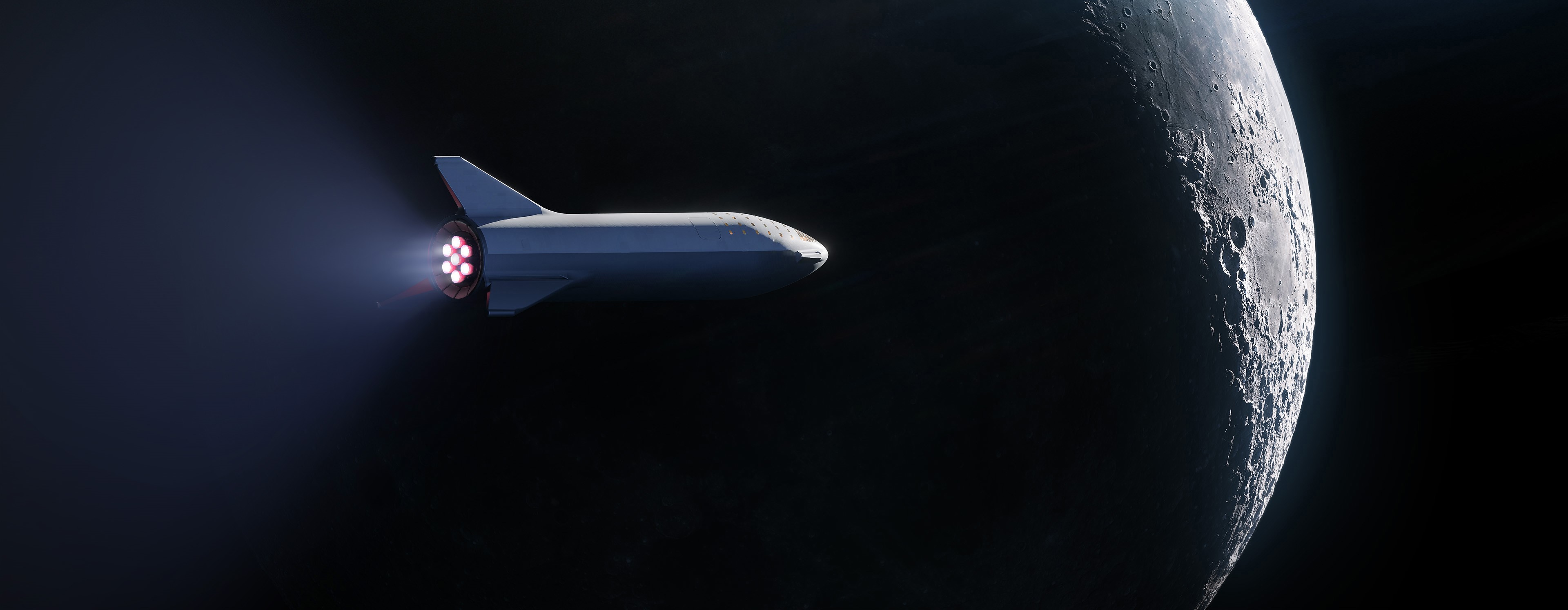
“We’ve built the first cylinder section…and we’ll be building the domes and the engine section soon.” – SpaceX CEO Elon Musk, September 2018
During that September 17th presentation, Musk did not parse his words despite a self-admitted tendency to look at SpaceX’s development program timelines (Falcon 9, Falcon Heavy, Dragon, BFR) through rose-tinted glasses. Just two months after he uttered the quote above, SpaceX has visibly either finished or nearly finished a 9-meter diameter BFR spaceship (BFS) tank dome.
Due to SpaceX’s opaque treatment of development programs (both literally for the tent and figuratively for official updates), it’s possible that this may even the second dome completed so far. Either way, it can be extrapolated – assuming that the layout of BFR 2017 is generally representative of BFR 2018 – that the first spaceship prototype will require two or three roughly identical tank domes. If the common-dome tank layout is basically the same (disclaimer: it might be quite different), then SpaceX may end up mounting BFS’ 7 Raptor engines almost directly to the rear of the bottom tank dome, requiring either significant structural reinforcement or a second uniquely-engineer and optimized dome.
- A tall platform was moved inside the tent around November 10th, likely to support the integration of the tank dome and barrel section. (Pauline Acalin)
- The dome was spied inside the tent on November 12. (Pauline Acalin)
- The dome (left) and barrel section (right) can now be integrated. (Pauline Acalin)
- BFR 2017’s spaceship engine section. (SpaceX)
- An overview of BFS (circa 2017). (SpaceX)O
Judging from SpaceX’s and Musk’s desire to make reusable rockets as reliable as (if not even more reliable than) commercial airliners, the safest form of mass-transit humans have created, it seems more likely than not that Raptor and BFR will continue SpaceX’s practice of quite literally surrounding each engine with thrust-transmitting structures that simultaneously act as armored shields. In the event that a Merlin engine fails on Falcon 9 or Heavy, each booster’s octaweb contains nine separate armored chambers that exist to isolate each engine in the event of a catastrophic failure. In fact, a Merlin failure – the only such in-flight failure known – during SpaceX’s CRS-1 Dragon launch in 2012 demonstrated the efficacy of this design, preventing the failure of just one of nine engines from causing total mission failure.
Rise of the ‘hexaweb’?
To replicate that design strategy on BFR (both booster and spaceship) would be an act of simple pragmatism – it’s always preferable to design for survivability and reliability than to couch launch and mission success primarily on the reliability of individual components. Because SpaceX chose not to share similarly detailed cutaways of BFR’s updated 2018 design, it’s unclear if the spaceship’s engine section (“hexaweb”, to borrow from “octaweb”) has changed dramatically.
Given the unexpected decision to move entirely away from a version of Raptor specifically optimized for vacuum operation for BFR’s first iteration, as well as the new presence of ~90 cubic meters of storage bins around the circumference of the spaceship’s aft, it’s possible that SpaceX will opt for a design more reminiscent of the Falcon family’s octaweb.
- The rear of SpaceX’s updated BFS.
- A better view. (SpaceX)
- A September 2018 render of Starship (then BFS) shows one of the vehicle’s two hinged wings/fins/legs. (SpaceX)
- A gif of Raptor throttling over the course of a 90+ second static-fire test in McGregor, Texas. (SpaceX)
Regardless, the appearance of a completed BFS tank dome is a major development on the vehicle’s path to integrated testing and paves the way for the fabrication of additional tank domes, barrel sections, engine sections, and more. Particularly obvious and noteworthy will be the fabrication of the prototype spaceship’s pointed cone-shaped nose section, its large tripod fins/wings/legs, and its two forward canard wings.
With all three fins/wings installed, BFS – in its current iteration – would have an unbelievable circumference of ~67 meters (220 feet) and a ‘finspan’ of perhaps 21 meters (~70 feet) tip to tip. BFS is going to be a very hard spaceship to hide.

Elon Musk
Elon Musk and Tesla AI Director share insights after empty driver seat Robotaxi rides
The executives’ unoccupied tests hint at the rapid progress of Tesla’s unsupervised Robotaxi efforts.

Tesla CEO Elon Musk and AI Director Ashok Elluswamy celebrated Christmas Eve by sharing personal experiences with Robotaxi vehicles that had no safety monitor or occupant in the driver’s seat. Musk described the system’s “perfect driving” around Austin, while Elluswamy posted video from the back seat, calling it “an amazing experience.”
The executives’ unoccupied tests hint at the rapid progress of Tesla’s unsupervised Robotaxi efforts.
Elon and Ashok’s firsthand Robotaxi insights
Prior to Musk and the Tesla AI Director’s posts, sightings of unmanned Teslas navigating public roads were widely shared on social media. One such vehicle was spotted in Austin, Texas, which Elon Musk acknowleged by stating that “Testing is underway with no occupants in the car.”
Based on his Christmas Eve post, Musk seemed to have tested an unmanned Tesla himself. “A Tesla with no safety monitor in the car and me sitting in the passenger seat took me all around Austin on Sunday with perfect driving,” Musk wrote in his post.
Elluswamy responded with a 2-minute video showing himself in the rear of an unmanned Tesla. The video featured the vehicle’s empty front seats, as well as its smooth handling through real-world traffic. He captioned his video with the words, “It’s an amazing experience!”
Towards Unsupervised operations
During an xAI Hackathon earlier this month, Elon Musk mentioned that Tesla owed be removing Safety Monitors from its Robotaxis in Austin in just three weeks. “Unsupervised is pretty much solved at this point. So there will be Tesla Robotaxis operating in Austin with no one in them. Not even anyone in the passenger seat in about three weeks,” he said. Musk echoed similar estimates at the 2025 Annual Shareholder Meeting and the Q3 2025 earnings call.
Considering the insights that were posted Musk and Elluswamy, it does appear that Tesla is working hard towards operating its Robotaxis with no safety monitors. This is quite impressive considering that the service was launched just earlier this year.
Elon Musk
Starlink passes 9 million active customers just weeks after hitting 8 million
The milestone highlights the accelerating growth of Starlink, which has now been adding over 20,000 new users per day.

SpaceX’s Starlink satellite internet service has continued its rapid global expansion, surpassing 9 million active customers just weeks after crossing the 8 million mark.
The milestone highlights the accelerating growth of Starlink, which has now been adding over 20,000 new users per day.
9 million customers
In a post on X, SpaceX stated that Starlink now serves over 9 million active users across 155 countries, territories, and markets. The company reached 8 million customers in early November, meaning it added roughly 1 million subscribers in under seven weeks, or about 21,275 new users on average per day.
“Starlink is connecting more than 9M active customers with high-speed internet across 155 countries, territories, and many other markets,” Starlink wrote in a post on its official X account. SpaceX President Gwynne Shotwell also celebrated the milestone on X. “A huge thank you to all of our customers and congrats to the Starlink team for such an incredible product,” she wrote.
That growth rate reflects both rising demand for broadband in underserved regions and Starlink’s expanding satellite constellation, which now includes more than 9,000 low-Earth-orbit satellites designed to deliver high-speed, low-latency internet worldwide.
Starlink’s momentum
Starlink’s momentum has been building up. SpaceX reported 4.6 million Starlink customers in December 2024, followed by 7 million by August 2025, and 8 million customers in November. Independent data also suggests Starlink usage is rising sharply, with Cloudflare reporting that global web traffic from Starlink users more than doubled in 2025, as noted in an Insider report.
Starlink’s momentum is increasingly tied to SpaceX’s broader financial outlook. Elon Musk has said the satellite network is “by far” the company’s largest revenue driver, and reports suggest SpaceX may be positioning itself for an initial public offering as soon as next year, with valuations estimated as high as $1.5 trillion. Musk has also suggested in the past that Starlink could have its own IPO in the future.
News
NVIDIA Director of Robotics: Tesla FSD v14 is the first AI to pass the “Physical Turing Test”
After testing FSD v14, Fan stated that his experience with FSD felt magical at first, but it soon started to feel like a routine.

NVIDIA Director of Robotics Jim Fan has praised Tesla’s Full Self-Driving (Supervised) v14 as the first AI to pass what he described as a “Physical Turing Test.”
After testing FSD v14, Fan stated that his experience with FSD felt magical at first, but it soon started to feel like a routine. And just like smartphones today, removing it now would “actively hurt.”
Jim Fan’s hands-on FSD v14 impressions
Fan, a leading researcher in embodied AI who is currently solving Physical AI at NVIDIA and spearheading the company’s Project GR00T initiative, noted that he actually was late to the Tesla game. He was, however, one of the first to try out FSD v14.
“I was very late to own a Tesla but among the earliest to try out FSD v14. It’s perhaps the first time I experience an AI that passes the Physical Turing Test: after a long day at work, you press a button, lay back, and couldn’t tell if a neural net or a human drove you home,” Fan wrote in a post on X.
Fan added: “Despite knowing exactly how robot learning works, I still find it magical watching the steering wheel turn by itself. First it feels surreal, next it becomes routine. Then, like the smartphone, taking it away actively hurts. This is how humanity gets rewired and glued to god-like technologies.”
The Physical Turing Test
The original Turing Test was conceived by Alan Turing in 1950, and it was aimed at determining if a machine could exhibit behavior that is equivalent to or indistinguishable from a human. By focusing on text-based conversations, the original Turing Test set a high bar for natural language processing and machine learning.
This test has been passed by today’s large language models. However, the capability to converse in a humanlike manner is a completely different challenge from performing real-world problem-solving or physical interactions. Thus, Fan introduced the Physical Turing Test, which challenges AI systems to demonstrate intelligence through physical actions.
Based on Fan’s comments, Tesla has demonstrated these intelligent physical actions with FSD v14. Elon Musk agreed with the NVIDIA executive, stating in a post on X that with FSD v14, “you can sense the sentience maturing.” Musk also praised Tesla AI, calling it the best “real-world AI” today.
